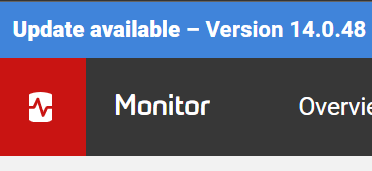Preparing to upgrade Redgate Monitor
Published 28 March 2024
Upgrading Redgate Monitor can require a schema upgrade as part of the installation. We recommend you back up the data repository database before you update.
Upgrading to a later version of Redgate Monitor retains your current monitoring data in the Data Repository. Redgate Monitor updates the Data Repository database schema to the newer version during installation.
How do I know when an upgrade is available?
When an upgrade is available, Redgate Monitor displays a message above the product name banner:
Click the link for information about the upgrade, and a link to download the installer.
Before upgrading
Before you upgrade to a later version, we recommend that you back up your current Data Repository. Once the upgrade is completed, you won't be able to roll back to a previous version of your Data Repository database.
Locating the Redgate Monitor Repository
If you can't find your Redgate Monitor repository database, see Locating the Redgate Monitor database .
Upgrading to SQL Monitor v13 or Redgate Monitor v14 or above
If you upgrade with a support and upgrades package, the v2, v3, v4, v5, v6, v7, v8, v9, v10, v11, v12 or v13 licenses expire and Redgate Monitor reactivates them as v14 licenses.
If reactivation fails, or the v2, v3, v4, v5, v6, v7, v8, v9, v10, v11, v12 or v13 license doesn't include support and upgrades, Redgate Monitor deletes the serial numbers from the Configuration > Licensing page and starts a 14-day trial of v14. You cannot roll back to the previous version.
If your v2, v3, v4, v5, v6, v7, v8, v9, v10, v11, v12 or v13 license doesn't include support and upgrades, we recommend that you install a trial version of v14 on a separate machine. When you're ready to purchase v14 licenses, you can add the support and upgrades package to make upgrading easier.
- To find your serial numbers, go to http://www.red-gate.com/myserialnumbers and enter your email address and password.
- To purchase a v14 license with the support and upgrades package, contact sales@red-gate.com.





